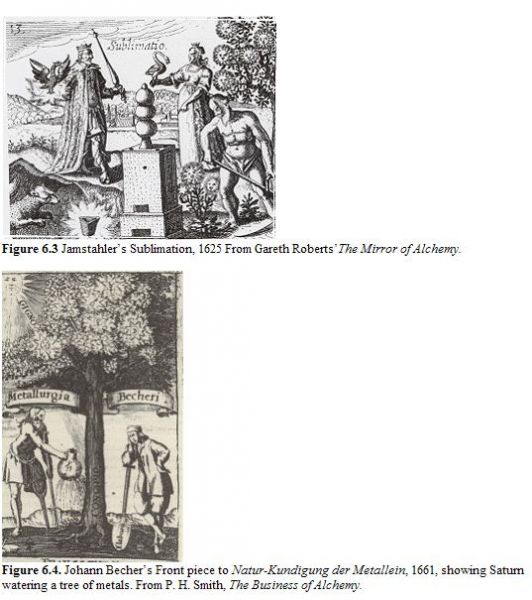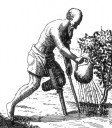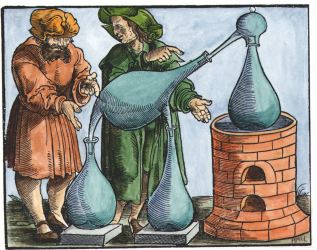| Author | Post |
|---|
Alexander Guthrie Stewart
Member
| Joined: | Sat Feb 16th, 2008 |
| Location: | |
| Posts: | 192 |
| Status: |
Offline
|
|
Posted: Mon Aug 24th, 2009 10:24 pm |
|
Hey, that photo looks very like the one I have that was made by Trinity Court potteries, who make replica pottery objects such as cups, plates etc.
They do go back to the 16th century and possibly before, although I've not seen any pictures or descriptions myself.
|
Marcella Gillick
Member
| Joined: | Tue Mar 4th, 2008 |
| Location: | |
| Posts: | 5 |
| Status: |
Offline
|
|
Posted: Tue Aug 25th, 2009 11:34 am |
|
Dear Rafal
There are another two of your sought-after images in the same text, with a bit more reference:-
Sublimation, the conversion of solid to gas, Figure 6.3, is shown by Jamstahler with Saturn in the lower right hand corner laboring to grow metals in a tree. The king and queen are again separated this time by the distillation process. A similar picture is shown from the frontispiece to Joachim Becher’s Natur-Kundigung der Metallen, 1661, in which Saturn with his symbol of a scythe (time) waters the tree of conception and with the help of the labor of alchemy grows the metals in the tree (Figure 6.4) (Smith, 1994, p.220).
And I’ve also found two references of this image in Sendivogius and Maier:-
Chymists and Chymistry’ by Lawrence Principe:-
Chapter 8: Newton’w theory of Metallic Generation in the Previously neglected Text “Humores minerals continuo decidunt”: William R Newman
Newtown uses the terms “Saturn” and “magnet” for the mercury of the metals. The lameness of this mercury is a reference to the depiction of Saturn in Sendivogius’s 1604 Novum lumen chemicum as a gardener; in Michael Maier’s later Symbola aureae mensae duodecim nationum, the Sendivogian gardner-Saturn is shown with an amputation below the knee. By watering his garden, this Saturn provides the mercurial moisture to metals, an essential part of their material substrate.
I hope this is of some use to you
Very best wishes
Marcella
Attached Image (viewed 538 times):
 Last edited on Tue Aug 25th, 2009 11:35 am by Marcella Gillick
|
Marcella Gillick
Member
| Joined: | Tue Mar 4th, 2008 |
| Location: | |
| Posts: | 5 |
| Status: |
Offline
|
|
Posted: Tue Aug 25th, 2009 11:49 am |
|
In addition it appears that Becher had a second image of Saturn, in his Parnassi Illustrati, Pars III, Miner alogia - as described below - along with Natur Kundigung (with a different date) - in ‘The Birth and development of the Geological Sciences’ by Frank Dawson Adams (cool book - free download on-line at http://www.archive.com)
Wherefore we reach the conclusion that metals and other minerals are subterranean plants having their birth within the earth. The frontispiece of Becher's Natur Kundigung der Metallen (Frankfort, 1705) presents an interesting allegorical picture of this metallic tree (Plate IX).
The rays from the sun are beating down on the roots of the tree. They bear the inscription "Gigno" (I beget). The trunk of the tree is inscribed with the word "Concipio" (I conceive). In the foliage of the tree are seen the signs of the metals gold, silver, mercury, copper, tin, and iron. The alchemical signs for sulphur and salt are in the earth at its roots. At the foot of the tree on either side stand two figures on the right that of a young man resting on his spade, which bears the word "Elaboro" (I obtain by labor); on the left that of an old man scantily clothed, who has lost one leg and is supporting himself on a crutch with one hand, while in the other he holds a pot from which he is watering the ground about the foot of the tree. This pot bears the symbol assigned by the alchemists to the metal lead. This figure represents the god Saturn, the planet bearing whose name was always coupled with the metal lead, in the writings of the alchemists. That this is the true interpretation of the figure is seen from the fact that essentially the same figure appears on page 26 in Becher's Parnassi Illustrati, Pars III, Miner alogia published at Ulm in 1662. Here, the old man is leaning on a scythe instead of a cutch, while over his head appears the word "Saturnus." This attribute apparently takes the place of the pruning.
best wishes
Marcella
|
Rafal T. Prinke
Member

| Joined: | Tue Mar 4th, 2008 |
| Location: | Poland |
| Posts: | 150 |
| Status: |
Offline
|
|
Posted: Thu Aug 27th, 2009 10:44 am |
|
Dear Marcella,
Thank you very much for both posts and the valuable references -- also that to the electronic edition of Frank Dawson Adams's book.
The figure in the Jamstahler emblem is probably Saturn, although he does not have other usual attributes than the scythe (and sadly no watering can/pot). But that from Becher is suberb! -- how could I overlook it? :-)
|
Paul Ferguson
Member

| Joined: | Fri Feb 15th, 2008 |
| Location: | |
| Posts: | 1538 |
| Status: |
Offline
|
|
Posted: Thu Aug 27th, 2009 11:15 am |
|
Rafal T. Prinke wrote:
Dear Marcella,
Thank you very much for both posts and the valuable references -- also that to the electronic edition of Frank Dawson Adams's book.
The figure in the Jamstahler emblem is probably Saturn, although he does not have other usual attributes than the scythe (and sadly no watering can/pot). But that from Becher is suberb! -- how could I overlook it? :-)
Becher's book is available as a free download from Google books:
http://books.google.com/books?id=5vETAAAAQAAJ&dq="Natur-Kundigung+der+Metallen"&printsec=frontcover&source=bl&ots=74VvnXS7I9&sig=ROTHDPMHD1AuF_HAto1Hv4W7gmw&hl=en&ei=UluWSvijEZPVjAeV9ojJDQ&sa=X&oi=book_result&ct=result&resnum=1#v=onepage&q=&f=false
A hand-coloured version of the image is A163 in Adam's series.
http://www.alchemywebsite.com/amclglr9.html
|
Rafal T. Prinke
Member

| Joined: | Tue Mar 4th, 2008 |
| Location: | Poland |
| Posts: | 150 |
| Status: |
Offline
|
|
Posted: Thu Aug 27th, 2009 10:01 pm |
|
Hi Marcella,
Marcella Gillick wrote: That this is the true interpretation of the figure is seen from the fact that essentially the same figure appears on page 26 in Becher's Parnassi Illustrati, Pars III, Miner alogia published at Ulm in 1662. Here, the old man is leaning on a scythe instead of a cutch, while over his head appears the word "Saturnus."
And this clue was crucial! Yes, the image from my original question is from that other book of Becher. There is a digital edition at HAB:
http://diglib.hab.de/wdb.php?dir=drucke/23-2-phys-2f-3
or just see the page in question:
http://diglib.hab.de/drucke/23-2-phys-2f-3/00026.jpg
Thank you Marcella and everyone else -- all suggestions and leads were helpful.
|
Carl Lavoie
Member
| Joined: | Wed Feb 25th, 2009 |
| Location: | Canada |
| Posts: | 215 |
| Status: |
Offline
|
|
Posted: Fri Aug 28th, 2009 06:38 am |
|
.
(Epilogue?) A little detail remains, though: how come the watering jug is different in the first Becher’s image provided by Marcella ...
http://books.google.com/books?id=5vETAAAAQAAJ&ots=74VvoUQ9N7&dq=Johann%20Joachim%20Becher%2C%20Natur-K%C3%BCndigung%20der%20Metallen%2C&pg=PP5#v=onepage&q=&f=false
... and the one Adam coloured (see image below)? The first has the ‘lead/Saturn’ symbol on the jug, while in Adam’s one, the watering jug is bare, but have some writing underneath (that I can’t make out). Could there have been two different printings? Adam, could you tell what it read in your version?

.
|
Paul Ferguson
Member

| Joined: | Fri Feb 15th, 2008 |
| Location: | |
| Posts: | 1538 |
| Status: |
Offline
|
|
Posted: Fri Aug 28th, 2009 10:33 am |
|
Carl Lavoie wrote:
.
(Epilogue?) A little detail remains, though: how come the watering jug is different in the first Becher’s image provided by Marcella ...
http://books.google.com/books?id=5vETAAAAQAAJ&ots=74VvoUQ9N7&dq=Johann%20Joachim%20Becher%2C%20Natur-K%C3%BCndigung%20der%20Metallen%2C&pg=PP5#v=onepage&q=&f=false
... and the one Adam coloured (see image below)? The first has the ‘lead/Saturn’ symbol on the jug, while in Adam’s one, the watering jug is bare, but have some writing underneath (that I can’t make out).
Seems to say:
ALO = I NOURISH
CONCIPIO = I CONCEIVE
and on the spade:
ELABORO = I TOIL OVER
|
Marcella Gillick
Member
| Joined: | Tue Mar 4th, 2008 |
| Location: | |
| Posts: | 5 |
| Status: |
Offline
|
|
Posted: Fri Aug 28th, 2009 06:56 pm |
|
Dear Rafal
You are very welcome - it was only just a bit of idle googling on my part, not something I know anything about  so I'm delighted that my contribution was of use. so I'm delighted that my contribution was of use.
very best wishes
Marcella
|

Current time is 09:33 am | Page:   1 2 1 2 |
|

